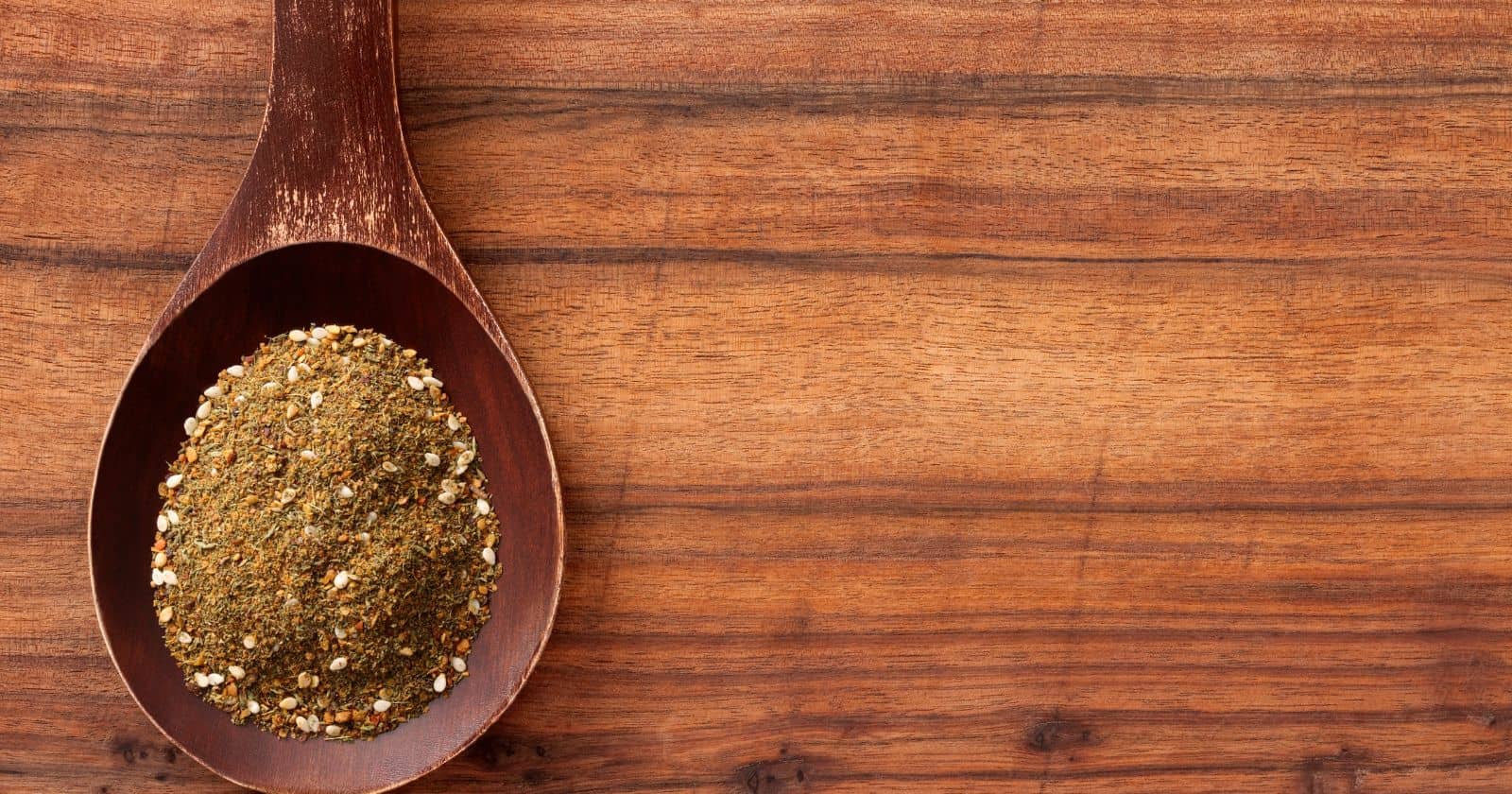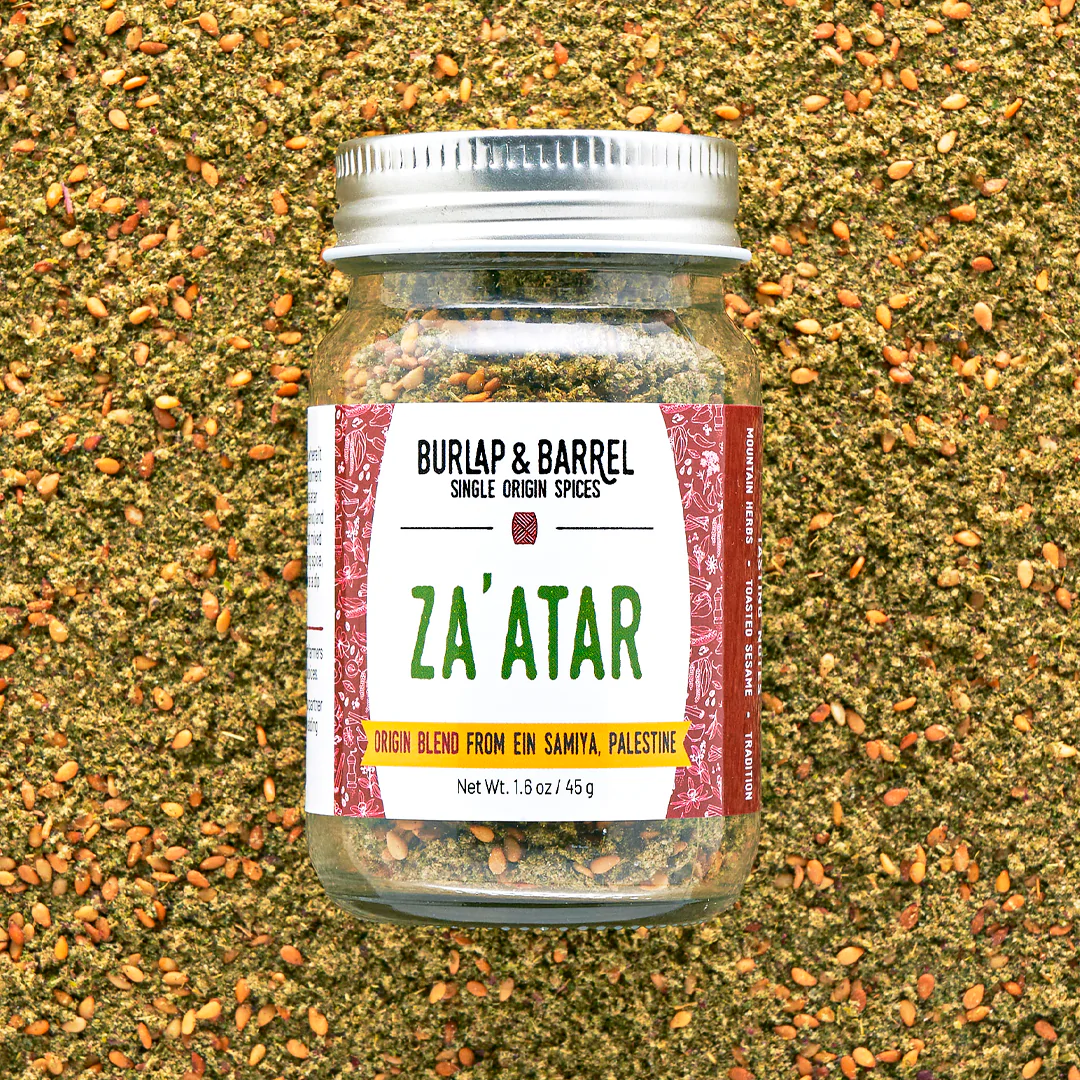If you’re a foodie looking to add a unique and exotic flavor to your dishes, you’ll want to know Zaatar!
Are you tired of using the same old spices in your cooking? Do you want to impress your guests with something new and exciting?
Zaatar is a Middle Eastern
In this ultimate guide, we’ll dive deeper into the history and origin of Zaatar, explore its health benefits, and show you how to make your blend at home.
We’ll also provide you with some mouth-watering recipes to try out. So, get ready to elevate your culinary game with the magical
What is Zaatar? Origins And Uses
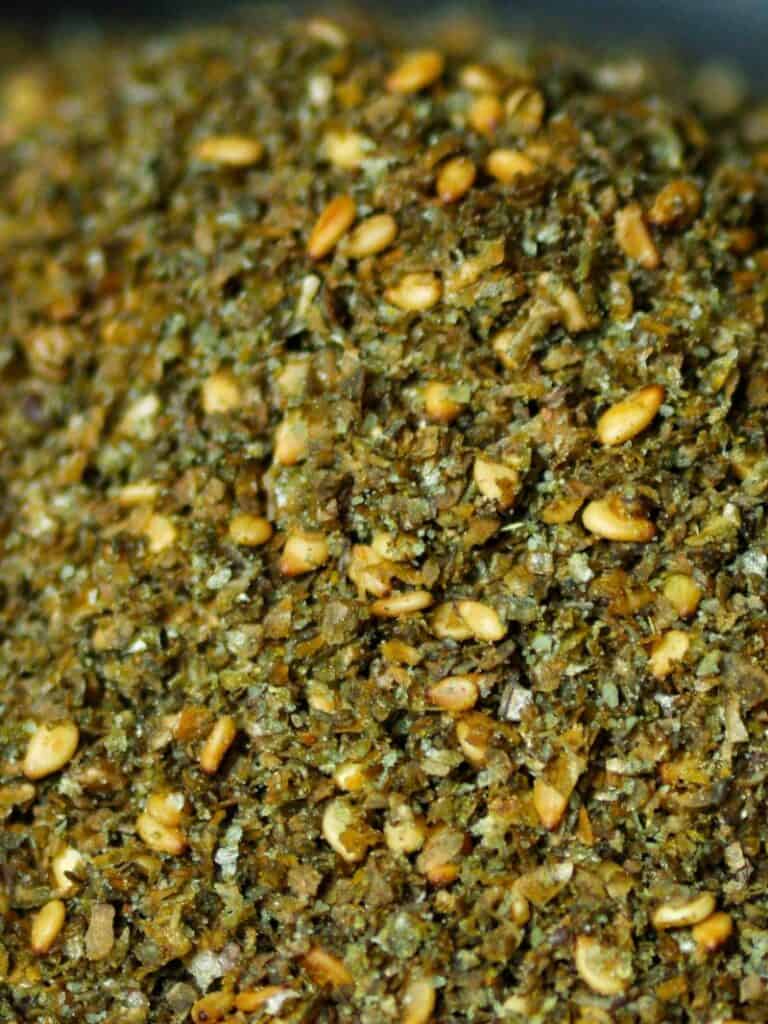
Za’atar is a venerable seasoning blend used in Middle Eastern cuisine. The name itself translates to “wild thyme,” The za’atar
Depending on the preparation and herbs used, specific recipes may include other ingredients such as toasted sesame seeds, ground sumac, marjoram, or even fresh thyme.
Its versatile flavor profile makes it a favorite among home cooks for adding complex notes to dishes.
In addition to its flavor, za’atar has been used for centuries for its health benefits. It’s known to be high in antioxidants and can help reduce inflammation from arthritis and other inflammatory diseases.
It’s also high in Vitamins A, and C, providing a notable boost of nutritional value in small amounts.
The key ingredients of the classic za’atar blend are wild oregano, sumac, thyme, and sesame seeds. These spices provide a unique combination of earthy sweetness, creating a robust flavor profile.
Wild oregano is often grown in the deserts of Israel and Egypt; sumac is native to Syria, while fresh thyme is found throughout Europe, Egypt, and Israel.
Additionally, the earthy, rich tones of the sesame seeds add a layer of complexity to dishes when included in the mix.
The exact origins of Zaatar are unclear, but it is believed to have been used by the ancient Egyptians and mentioned in the Bible.
The Key Ingredients Of Zaatar Spice : Thyme, Sumac, And Sesame Seeds
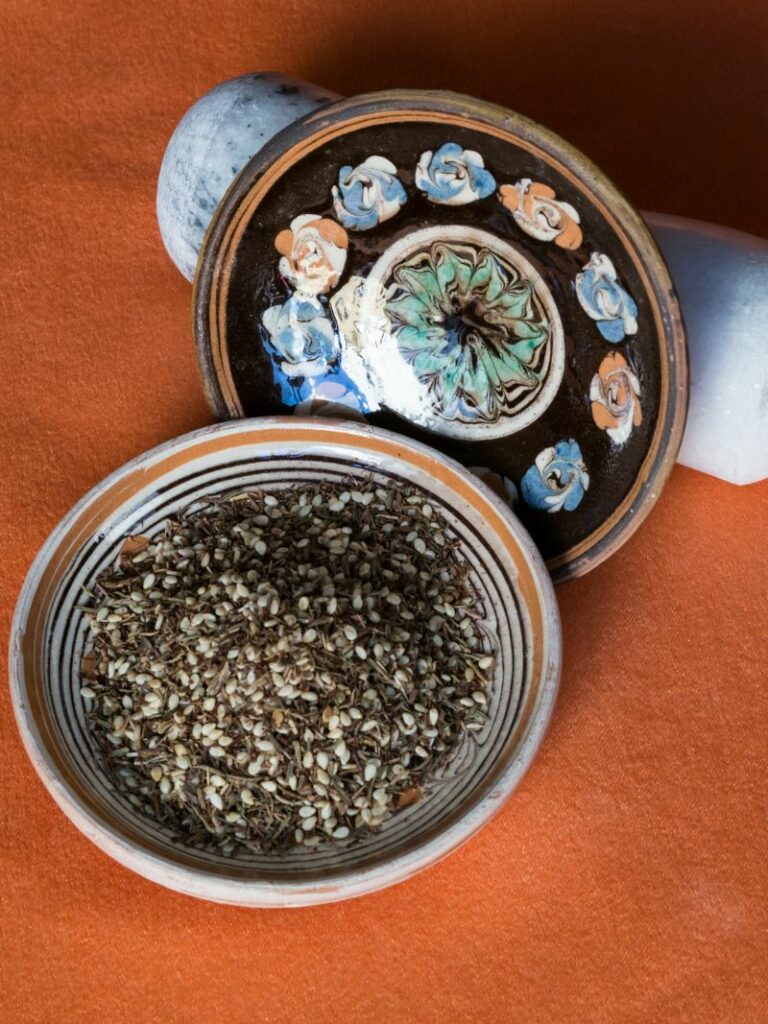
While the base components—thyme, sumac, and sesame seeds—are known to remain consistent across different cuisines and origins of the
Other facts commonly appearing in zaatar include oregano, marjoram, coriander, cumin, shummar, salt, dried orange zest, and other regional herbs such as zaatar itself.
Depending on the chef or house-maker crafting this delectable mix of herbs and spices into a flavorful blend knows no bounds.
Variations of zaatar
Health Benefits Of Zaatar Spice
Zaatar has become popular due to its unique flavor, recipe versatility, and excellent health benefits attributed to its antioxidant and anti-inflammatory properties.
Here are some health benefits that may include in zaatar spices:
- It contains antioxidants that may help prevent cellular damage and reduce inflammation
- It may boost the immune system due to its antibacterial and antiviral properties.
- Rich in vitamins and minerals such as Dietary fiber, Potassium, iron, and calcium
- It may aid in digestion and improve gut health.
- It may help improve cognitive function and memory.
- It may have anti-cancer properties and help protect against certain types of cancer.
- It may help lower cholesterol levels and improve heart health.
- It can be a healthy alternative to salt for flavoring food.
This fragrant blend is incredibly versatile as it can be used to dip breads into a zaatar olive oil mixture or sprinkle over roasted vegetables or egg dishes for added flavor.
It has also been known to enhance the flavor of marinades or sauces for meats or fish. Applied generously on falafel and shawarma sandwiches adds flavor to each bite!
Additionally, Zaatar mix can be used as a seasoning for salads or blended with other herbs like parsley or mint to make condiments such as tabbouleh.
Culinary Uses Of Zaatar Spice : Sprinkling, Dips, And Marinades
Zaatar
It can easily be sprinkled onto dips and added to roasted vegetables like cauliflower and broccoli for an added layer of flavor.
Zaatar is often used in marinades for grilled or roasted poultry or meats and mixed into dips, salads, and egg dishes.
Not only can it be used for culinary purposes, but it can also be set on the table as a condiment to be added to dishes. Make sweet potato fries dipped in a yogurt-based sauce infused with Zaatar
Here are some savory dishes that feature Zaatar spices:
Zaatar Roasted Chicken

Rub chicken with a mixture of Zaatar, olive oil, and lemon juice before roasting in the oven. The result is a flavorful and juicy chicken with crispy skin.
Zaatar Baked Fries
Toss sliced potatoes with Zaatar and olive oil before baking in the oven. The Zaatar adds an extra layer of flavor to the crispy fries. Recipe here.
Zaatar Meatballs
Mix ground meat with breadcrumbs, egg, and Zaatar before shaping it into meatballs and baking in the oven. The Zaatar adds a savory and slightly tangy flavor to the meatballs.
Zaatar Flatbread

Mix Zaatar into a dough and bake it in the oven for a delicious and fragrant flatbread that pairs well with dips and spreads.
Zaatar Roasted Vegetables
Toss sliced vegetables with Zaatar and olive oil before roasting them in the oven. The Zaatar adds a delicious and earthy flavor to the vegetables.
Zaatar Hummus
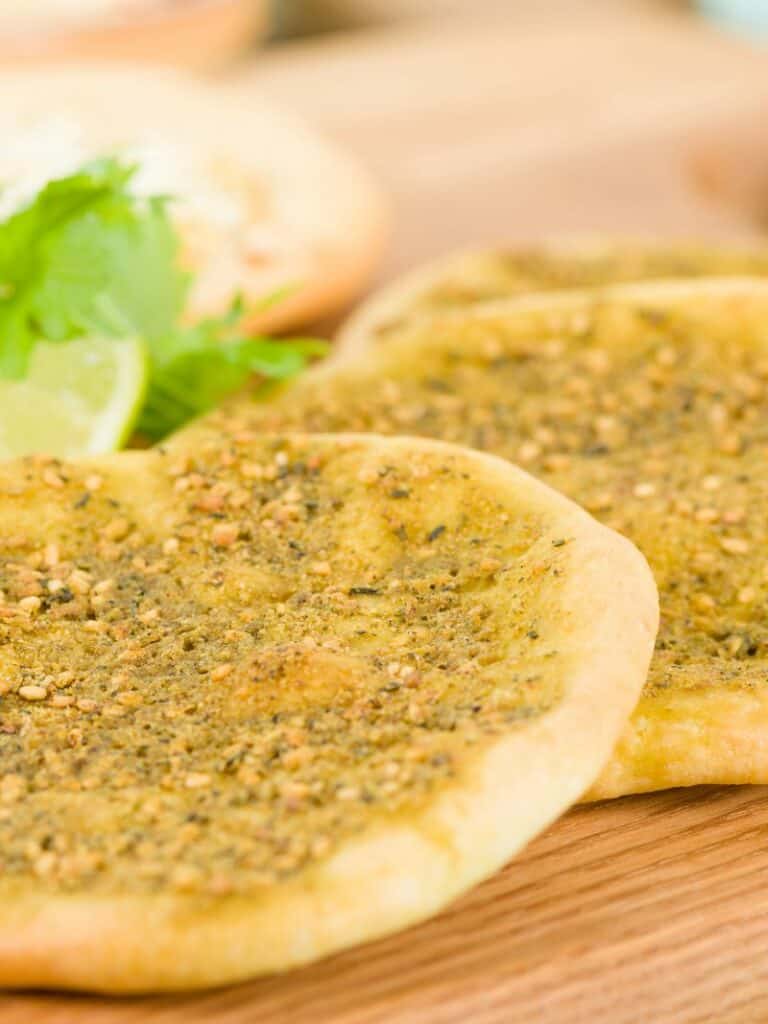
Mix Zaatar into homemade or store-bought hummus for an extra burst of flavor. Serve with pita bread or vegetables for a tasty and healthy snack.
Tips For Buying And Storing Zaatar Spice : Freshness And Quality
For the best tasting results, buying quality Za’atar from a reputable source is essential. Look for vibrant and fragrant products – signs of freshness as these indicate that you’ll get the most out of them for your cooking.
Store Za’atar in an airtight container away from heat and light. Once opened, pre-blended or mixed, Za’atar can last up to two weeks on the countertop or cupboard, while whole spices can keep up to four years stored in an airtight container in a drawer or cupboard away from direct sunlight or heat sources.
The same rule applies to all herbs and spices: store them in airtight containers to prolong their shelf life.
Zaatar Substitutes
If you don’t have access to Zaatar or run out of it, there are several substitutes you can use to recreate its unique flavor profile.
Here are some Zaatar substitutes:
Thyme, sumac, and sesame seeds
Mix dried thyme, sumac, and sesame seeds for a simple Zaatar substitute.
Dried oregano, sesame seeds, and lemon zest
Mix equal parts dried oregano, sesame seeds, and lemon zest for a Zaatar substitute that is slightly more citrusy.
Dried thyme, dried marjoram, and sesame seeds
Mix equal parts dried thyme, dried marjoram, and sesame seeds for a Zaatar substitute that is slightly sweeter.
Dried basil, dried thyme, and sesame seeds
Mix equal parts dried basil, dried thyme, and sesame seeds for a Zaatar substitute that is more herbaceous.
Dried rosemary, sumac, and sesame seeds
Mix equal parts dried rosemary, sumac, and sesame seeds for a Zaatar substitute that is more earthy.
When using a Zaatar substitute, start with a small amount and adjust to taste. While the reserves may not have the same flavor profile as Zaatar, they can still add a unique and delicious flavor to your dishes.
How To Make Zaatar Spice At Home: Recipes And Techniques
How To Make Zaatar Spice At Home
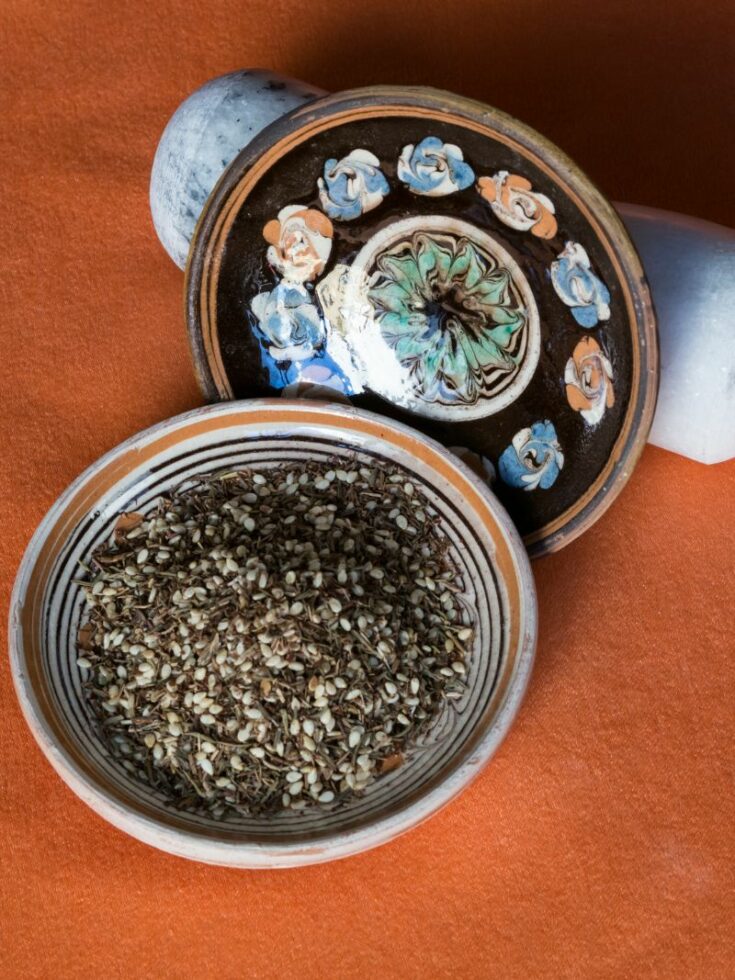
Zaatar spice is a staple ingredient in Middle Eastern cuisine and can add a delicious and exotic flavor to a wide variety of dishes.
Making your own Zaatar spice blend is easy and can be a fun way to experiment with different flavors and herbs.
Ingredients
- 1/4 cup sumac
- 1/4 cup dried thyme
- 2 tbsp sesame seeds
- 2 tbsp dried oregano
- 2 tbsp dried marjoram
- 1 tsp salt (optional)
Instructions
- In a dry skillet, toast the sesame seeds over medium heat until golden brown, stirring frequently. Remove from the skillet and let cool.
- In a mixing bowl, combine the sumac, dried thyme, toasted sesame seeds, dried oregano, and dried marjoram. Mix well until all the ingredients are evenly distributed.
- If desired, add the salt and mix again.
- Transfer the Zaatar spice blend to an airtight container and store it in a cool, dry place.
Notes
You can use this Zaatar spice blend in a wide variety of dishes, from dips and spreads to roasted vegetables and meat dishes. Experiment with different recipes and techniques to find your favorite ways to use this versatile and delicious spice blend.
Some tips and tricks on how to use Zaatar
- Use Zaatar as a seasoning: Sprinkle Zaatar over roasted vegetables, meat dishes, or pasta for extra flavor. It can also be used as a rub for chicken or fish.
- Mix Zaatar into dips and spreads: Add Zaatar to hummus, baba ganoush, or tzatziki for a delicious and aromatic twist on classic dips.
- Add Zaatar to bread and pastries: Mix Zaatar into bread dough or sprinkle it over flatbreads and pastries for added flavor.
- Use Zaatar in marinades: Mix Zaatar with olive oil and lemon juice to create a flavorful marinade for chicken, fish, or vegetables.
- Use Zaatar as a topping: Sprinkle Zaatar over avocado toast, eggs, or salads for a unique and delicious flavor profile.
- Make a Zaatar olive oil dip: Mix Zaatar with olive oil and use it as a dipping sauce for bread or vegetables.
- Add Zaatar to popcorn: Sprinkle Zaatar over freshly popped popcorn for a unique and flavorful snack.

